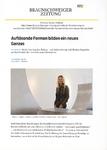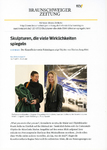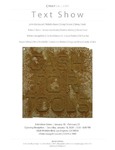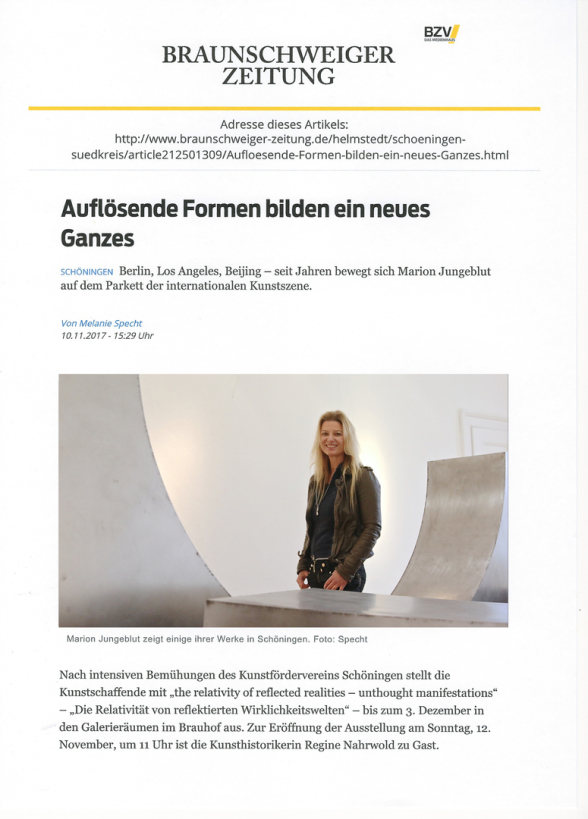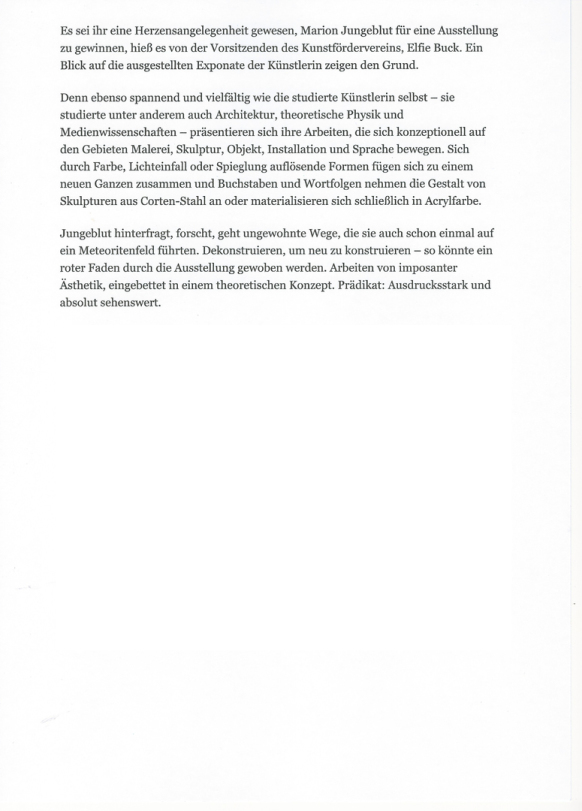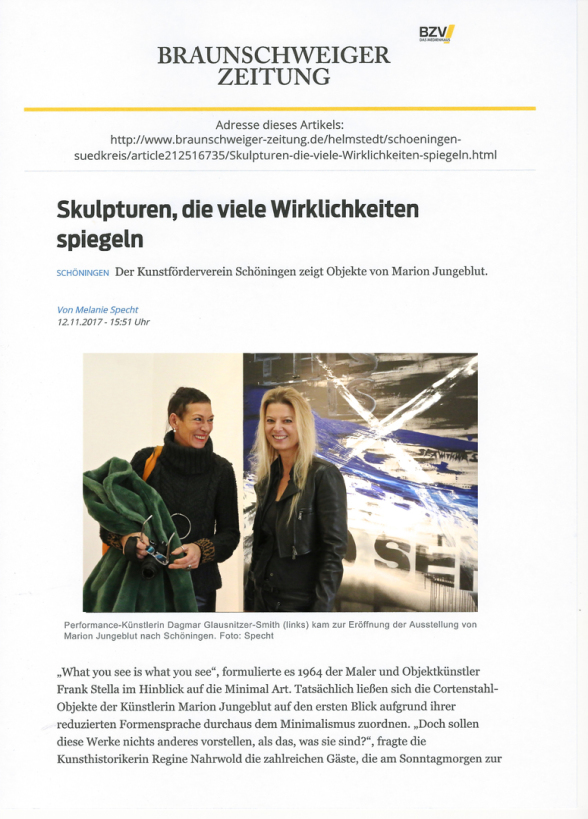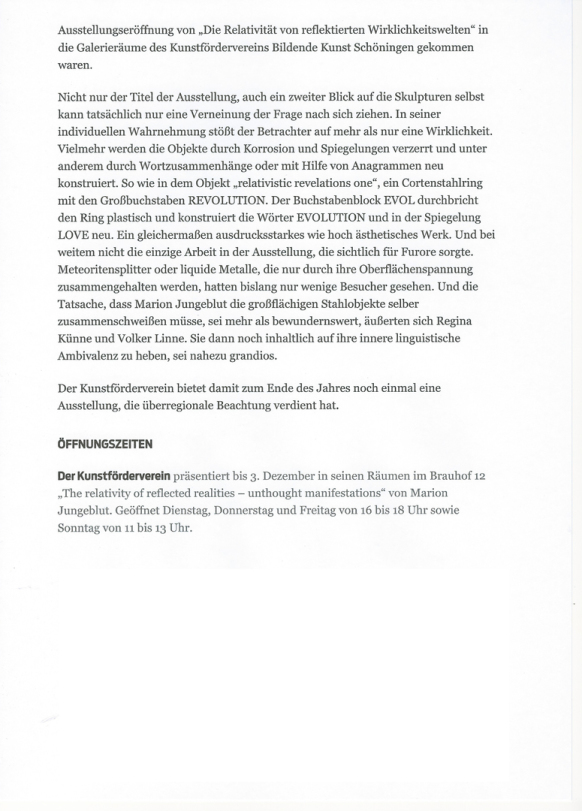Eröffnung trace versus space
BBK 02.09.2022
Marion Jungeblut und Carol Kaufman
...Jungeblut fügt in ihrem Werk das Grenzenlose und die Begrenzung zusammen, verbindet Naturwissenschaft mit Philosophie, überführt materielle Faktizität in immaterielle Denkräume und dies alles mit einer klaren Formsprache und kühlen Materialität.....
.....Kaufman sagt von sich: „The paintings are a history of my dialogue and meditative approach.” Die Gemälde zeigen die Geschichte meines Dialoges und meiner meditativen Herangehensweise.
Betrachtet man Kaufmans Arbeiten, dann tastet der Blick das Gitter ab, er taucht ein in das Gleichmaß der Form, erforscht ihr Inneres, zieht über die Feinheit der Linien und die Erhebungen der Ölfarbe. Der Geist beruhigt sich, die Worte verlieren sich in Farbe und Form und verblassen. Er kehrt zurück in den Körper, kann eins werden mit der Atmung und ist wieder ganz bei sich......
Marion Jungeblut fordert mit ihrem Werk zur Reflexion über das Dasein auf verschiedenen Ebenen auf. Die Erschaffung ihrer Skulpturen erfordert großen körperlichen Einsatz. Ihre Freude am Entdecken, am Denken und Gestalten von Wirklichkeit ist in allen Arbeiten spürbar.
Carol Kaufmans grids sind wie eine Basslinie, die es uns ermöglicht, immer wieder auf die wesentlichen Dinge des Daseins zurückzukommen, damit der Geist die nötige Ruhe findet, um sich entweder wieder zu intellektuellen Höhenflügen aufzuschwingen oder einfach nur, um seinen inneren Frieden zu finden....
Pia Kranz, Kunstwissenschaftlerin.
Carol Kaufman and Marion Jungeblut
Trace Versus Space/Trace Versus Time
Trace Versus Space/Trace Versus Time at the Kunsthaus of the BBK Braunschweig presents the work of two highly accomplished artists who might appear to have little in common. Carol Kaufman, an American who lives in Los Angeles, is a meditative, repetitive mark-maker who entices viewers into dense fields of mysterious complexity. Marion Jungeblut, a German based in Braunschweig, is a multifaceted sculptor and printmaker who invites her audience to interact with reflective surfaces, suspended forms, and three-dimensional words with equivocal meanings. It is tempting—and probably true—to say that Kaufman pulls inward while Jungeblut pushes outward, but the exhibition is more than a study in contrasts. It is also an aesthetic and philosophical conversation about the multi-layered nature of art, shifting realities, and human perceptions of time and space.
The two artists met in Los Angeles in 2019 through a mutual friend. “When I visited Carol’s studio, I became very interested in her art because she is so Minimalistic and her work is determined and ruled by lines that reveal a moment in time,” Jungeblut said. “At first sight, her process is invisible, but then the whole presence of a measured, time-and-space sequence culminates on a two-dimensional plane.” Kaufman was equally impressed with Jungeblut’s philosophical breadth, technical expertise, and fearless spirit. “I love Marion’s work,” she said. “She builds all her pieces. I think it is really important for a woman whose work demands strength to build it herself.” Kaufman approaches her own work emotionally and as a conscious feminist, so it is not surprising that she senses a strain of feminism in Jungeblut’s work as well. Jungeblut attributes her creative evolution to an upbringing that did not restrict adventurous girls, but agrees with Kaufman’s assertion that their work is connected on many levels.
Their paths to becoming artists are strikingly different, though. “My background is just art school,” said Kaufman, who went to the Boston Museum School of Fine Arts for one year and then transferred to the California Institute of the Arts, where she received a Bachelor of Fine Arts degree in 1974. As she describes it, her continuing work is “a structure formed by repetitive organic lines or ruled lines creating an abstract mesmerizing surface.” Concentrated and dedicated though she is, her labor-intensive process of mark-making in pencil or oil paint is not intended to produce a flawless product but “an artwork that has life on or beyond its surface and has no vocabulary except its own.” Kaufman has a history of making mostly dark, dense, rectangular fields of tiny lines that require unusually close attention from viewers. Relatively new works in the exhibition, including panels that read as blocks of grids or stripes, are much more colorful and approachable, but still offer infinite subtleties and what she calls “internal space.”
Jungeblut has been engaged with art since her youth, but she initially concentrated on mathematics and architecture. After receiving a degree in architecture from the Technische Universität Braunschweig in 1990, she worked at the Los Angeles office of a Skidmore Owings & Merrill, an architecture, urban planning, and engineering firm, and—in her spare time--received a private pilot’s license. After returning to Germany, she studied screen printing, film, and media sciences at the Braunschweig University of Art HBK Fine Art. When asked about the challenge of accomplishing all that, particularly as a woman, she responded: “For me, there was never a limit. I just did what I wanted.” The exhibition offers insight into her versatility in dealing with materials, methods, and ideas. Viewers experience a widely varied body of work conceived as part of several provocatively titled series, such as “Unthought Manifestations” and “Revelation of the Relativity of Realities.” Massive metal arcs, for example, reflect parts of themselves as well as the people who walk around or under them. The German word ZEITRAUM and RAUMZEIT (SPACE OF TIME and SPACE TIME in English) appears as a cube of space, circumscribed by laser-cut stainless steel letters and viewable from all angles. Both words reflecting themselves also with mirroring surfaces in an infinite loop, creating a sculptural approach to the definition of time as a reflection of light particles between mirroring surfaces in space – it leaves the viewer to reflect about the word, its meaning and the connection between meaning, word (linguistic) and (visual) perception in different layers of reality which plays a decisive role in Jungeblut’s art. Among other multifaceted works, deep blue screen prints explore an interchange of water, waves, and words.
When writing about her work, Jungeblut sometimes conjures up a poetic but purposeful play of words that invites multiple interpretations. The dual exhibition calls for open minds as well. There are no answers, just questions about looking and seeing amid changing relationships and points of view. What the two artists clearly share is a passion for making art that traces time, space, and surface through fascinating territory.
Suzanne Muchnic
Suzanne Muchnic, a long-time art writer for the Los Angeles Times and contributor to many art catalogs and periodicals, also has authored prize-winning books, including Odd Man In: Norton Simon and the Pursuit of Culture and LACMA So Far: Portrait of a Museum in the Making.
TRACE VERSUS SPACE/TRACE VERSUS TIME
Marion Jungeblut Carol Kaufman
Marion Jungeblut and Carole Kaufman present the exhibition "Trace versus Space Trace versus Time". Already the title evokes associations of the Minkowski-space, in which space and time are merged to form a four dimensional space-time-space. In the exhibition space and time appear as interchangeable structures. Within the exhibited objects, the photons travel between mirrors leaving traces in the physical space that can be perceived by the spectator. While the photons travel in time through the physical space at the speed of light, their infinite reflection generates a novel perception of physical structures arranged in space. The reflection alone induces a depth in the perceived space inside the objects, a depth that does not exist in the real physical space of the object but is still present in our reflection on our visual perception. The signals delivered to our visual cortex trained to understand the real world associates an infinite space inside of the objects which, though, have clearly defined physical boundaries in the real world, just because the photons trapped to reflect forth and back between the mirrors in infinite loops. The cage for the photons becomes the source of our deliberated imagination of infinite space.
It is remarkable how Jungeblut and Kaufman manage to
induce this transition from infinite reflected traces in a constraint space to an infinite space generated exclusively by the reflection in our connected network of neurons. The objects of the
artists emerge as analogues of monades as introduced by Leibniz, which are living mirrors of the universe and in which the information about the whole world is reflected in every of its elements. As
such, this work evokes deep insights into the scale-free properties of our universe. It is fascinating to reflect on the artists' objects and to discover the infinite richness of the structures
emerging within the limited physical space of each object.
Prof.Dr. Michael Meyer-Hermann
Michael Meyer-Hermann is a Theoretical Biologist at the Helmholtz Centre for Infection Research and full professor at the University of Braunschweig/Germany. He is a long time author of scientific articles in the fields of Physics, Biology and Immunology with a particular focus on the interactions between the different compartments of the human organism www.systems-immunology.de
https://cmaygallery.com/text-show
Text Show
John Baldessari | Kristin Bauer | Greg Colson | Ginny Cook
Robert Dean | Alexandra Grant | Bettina Hubby | Steve Hurd
Marion Jungeblut | Cecilia Miniucchi | Laura Parker | Ed Ruscha
Susan Silton | Allen Tombello | Lawrence Weiner | Augusta Wood | Jody Zellen
January 18 - February 22, 2020
CMay Gallery is pleased to present Text Show, a group exhibition featuring artists who use text as part of their visual language.
Curated by Carl Berg, the exhibition is a follow-up to a show he organized in 1998 titled “Text and Numbers” at the Remba Gallery in West Hollywood.
The exhibition includes four of the original artists, Greg Colson, Steve Hurd, Ed Ruscha and Jody Zellen and thirteen newcomers to the show: John Baldessari, Kristin Bauer, Ginny Cook, Robert Dean,
Alexandra Grant, Bettina Hubby, Marion Jungeblut, Cecilia Miniucchi, Laura Parker, Susan Silton, Allen Tombello, Lawrence Weiner and Augusta Wood.
Text continues to be an important form of art making and since the first show, twenty two years ago, several new artists have come to the forefront whose interesting work represents a stimulating
addition to the original show.
Most of the artists are LA-based with the exception of Kristin Bauer, Marion Jungeblut and Lawrence Weiner whose work fully fits into the tradition of text-based art. They belong to different
generations and survey a broad range of interpretations of the subject.
Los Angeles had been a mainstay for “Text Art” for many decades and continues as an important form of visual expression. The use of text in art is worldwide but Los Angeles has a very specific
connection to language and the visual form through its own historical connection to cinema. Words and images are therefore rooted in the LA psyche making this exhibition the perfect fit be held in
this city.
The show focuses on the relationship of text and image and on how each artist blends them into their interpretation of the subject. Works in diverse media including printmaking, photography,
painting, collage and sculpture are featured in the exhibition showing once more the current trend of this art form.
https://cyprus-mail.com/2021/05/14/exhibitions-at-goethe-look-at-bodys-connection-to-the-earth/
Exhibitions at Goethe look at body’s connection to the Earth
After a series of lockdowns, KunstRaumGoethe, Goethe-Institut Cyprus’ art space, is now hosting its second edition to welcome artists, art lovers and guests to two new exhibitions.
The exhibitions Interlaced – Verflochten zwischen Schichten by German artists Dagmar Glausnitzer-Smith and Marion Jungeblut and Acrobat Above the Dome by Cypriot photographer Stelios Kallinikou explore the body’s connection to the earth and will run until June 9.
The works in the exhibition Interlaced are brought into a context that juxtaposes the familiar, the abstract and the foreign. Words and reflective surfaces create the possibility of other realities, layers, and insights. Due to its abstraction, the artwork arouses different associations in the viewer’s mind on different levels of cognitive and visual perception.
Marion, with a background in sculpting, and Dagmar in performance art among other art forms, have collaborated in the past and have taken their contribution to this exhibition ‘Interlaced’ as an experiment for future work together. Though their work is of different formats, materials and approaches, the two German artists seek that gap where their art, or understanding of art, meets. In other words, where it intersects, relating to the title of their exhibition.
Presented in the same space is Kallinikou’s exhibition, a series of photographs that look more like abstract images – sometimes as paintings, others as illustrations – than classical photographs. There’s no clear separation between the two exhibitions other than Stelios’ work being presented on the stage and the room right next to it. It is this non-existent separation between the exhibitions that creates an interesting element on their relationship, even though at first glance it seems that they have nothing in common.
Kallinikou presents sequences of images that flow into nested dialogues as he explores the connection between the narrative boundaries of photography and consciousness. His images have a mythological and archaeological pre-human feel, connecting something primordial to the present by illustrating the body’s connection to the earth. The worlds are constructed at an introspective, meditative pace, and then function as speculative scenarios through which the intersections between territorial and ideological concepts related to landscape – such as space/place and time/history-are explored.
A similar meditative approach is present in Dagmar’s work too, although it is a completely different art form. Marion also focuses on reflection and introspection, much like the other two artists, thus by looking at the three artists’ understanding of their art practices and processes, they even surprise themselves in finding similarities in their concepts. To a visiting eye, these won’t be obvious most likely yet the artists encourage viewers to create their own narratives and reflections within their work, finding the acrobat interlaced above the dome.
Interlaced – Verflochten zwischen Schichten and Acrobat Above the Dome
Exhibition by German artists Dagmar Glausnitzer-Smith and Marion Jungeblut and another exhibition by Cypriot photographer Stelios Kallinikou. May 13-June 9. Goethe-Institut Cyprus, Nicosia. Monday-Friday 2pm-7pm, Saturday 10am-2pm, upon appointment at kultur-nikosia@goethe.de or 22-674606
https://in-cyprus.philenews.com/in-cyprus/acrobat-above-the-dome-and-interlaced-by-goethe-institute/
“A parachute only works
if you pull the ripcord and open it.
It requires a conscious effort,
but if you are not conscious…
can someone else do it for you?”
Stelios Kallinikou presents sequences of images that flow into nested dialogues as he explores the connection between the narrative boundaries of photography and consciousness. His images have a mythological and archaeological pre-human feel, connecting something primordial to the present by illustrating the body’s connection to the earth. The worlds are constructed at an introspective, meditative pace, and then function as speculative scenarios through which the intersections between territorial and ideological concepts related to “landscape”-such as space/place and time/history-are explored
https://www.freigeistreich.de/blog/2017/11/12/ausstellung-the-relativity-of-reflected-realities-von-marion-jungeblut-im-kunstfoerderverein-schoeningen/
le grand bleu
„Im Rausch der Tiefe“ heißt ein Kultfilm aus den 80er Jahren von Luc Besson über das Tiefseetauchen. Die faszinierenden Bilder des Filmes zeigen eine surreale andere Welt – die dominierende Farbe dieser Welt ist ein tiefes Blau. Die Bilder und Skulpturen der Künstlerin Marion Jungeblut aus Braunschweig und Los Angeles sind in eben diesem Blau gehalten und ziehen den Betrachter ebenso in ihren Bann – den Bildraum einer anderen Welt. Die Künstlerin erfährt sie jeden Tag, denn sie ist eine leidenschaftliche Schwimmerin. Jeden Morgen durchpflügt sie das Schwimmbecken ihrer Stadt oder die Wellen des nächstgelegenen Meeres, taucht ein in diese flüssige Materie. Hier gelten andere Gesetzmäßigkeiten der Schwerkraft, der Akustik, der Temperatur und dem Spiel des Lichtes und der Farben. Atmung, Körpertemperatur und Bewegung passen sich dem Rhythmus des Wassers an. All diese physischen und psychischen Erlebnisse und Erfahrungen spiegeln sich in der Kunst von Marion Jungeblut und lassen uns Teil haben an dem Gefühl von Schwerelosigkeit und Tiefe. „the water is where I come from, the water is where I fly, the water is where I drown, the water is where I die“ ist der Titel ihrer Wave Paintings. Der Magie des Wassers und dem Blau dieser Bilder und Skulpturen kann man sich schwer entziehen.
Beate Engelhorn
Kuratorin Aedes Berlin
what you see is what you get or the inner secret - the inner truth: the inner secret of the painting or sculpture is not revealed, the inner truth of the painting is the painting as itself and has its own elastic reality.
Das Bild ist wie ein Katalysator, der nicht verändert wird, sondern seine eigene innere Wahrheit behält, indem er sich entzieht.
Marion Jungeblut arbeitet mit Öl-Farbräumen und Acryl-Ebenen, silkscreens und c-prints von Körpern und Landschaften, mit Acrylplastiken, die zu schweben scheinen, die sich an ihren spiegelnden Oberflächen auflösen und sich der vollständigen Erfassung entziehen.
catalogue kunst hier und jetzt 2013
